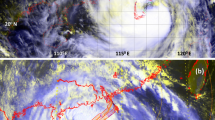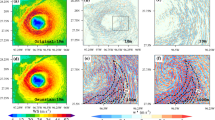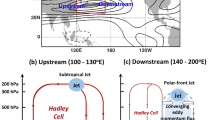Abstract
Boundary-layer secondary circulations or ‘roll vortices’ can have a significant influence on the turbulent exchange of momentum, sensible heat and moisture throughout the hurricane boundary layer. In this study, analyses of data from a WP-3D aircraft of the National Oceanic and Atmospheric Administration (NOAA) are presented. As part of the Coupled Boundary Layer Air-Sea Transfer (CBLAST)-hurricane experiment sponsored through the Office of Naval Research and NOAA’s annual hurricane research program, flights were conducted to investigate energy exchange across the air–sea interface. We present the first in-situ aircraft-based observations of rolls in the hurricane boundary layer and investigate their influence on energy and momentum exchange. The rolls detected in Hurricane Isidore (year 2002) have a characteristic wavelength of about 900 m, in good agreement with analyses of data from a synthetic aperture radar image captured by the Canadian Space Agency’s RADARSAT satellite in the same storm. Our analyses of the airborne data suggest that roll vortices may be a significant factor modulating the air–sea momentum exchange.
Similar content being viewed by others
References
Alpers W, Brümmer B (1994) Atmospheric boundary layer rolls observed by the synthetic aperture radar aboard the ERS-1 satellite. J Geophys Res 99: 12613–12621
Banner ML, Chen W, Walsh EJ, Jensen JB, Lee S, Fandry C (1999) The Southern Ocean Waves Experiment. Part I: overview and mean results. J Phys Oceanogr 29: 2130–2145
Black PG, D’Asaro E, Drennan WM, French JR, Niiler PP, Sanford TB, Terrill EJ, Walsh EJ, Zhang JA (2007) Air-sea exchange in hurricanes: Synthesis of observations from the Coupled Boundary Layer Air-Sea Transfer experiment. Bull Amer Meteorol Soc 88: 357–374
Brooks IM, Rogers DP (1997) Aircraft observations of boundary layer rolls off the coast of California. J Atmos Sci 54: 1834–1849
Brown RA (1970) Secondary flow model for the planetary boundary layer. J Atmos Sci 27: 742–757
Brown RA (1980) Longitudinal instabilities and secondary flows in the planetary boundary layer: a review. Rev Geophys Space Phys 18: 683–697
Brümmer B (1999) Roll and cell convection in winter-time arctic cold-air outbreaks. J Atmos Sci 56: 2613–2636
Chen W, Banner ML, Walsh EJ, Jensen JB, Lee S (2001) The Southern Ocean Waves Experiment. Part II: sea surface response to wind speed and wind stress variations. J Phys Oceanogr 31: 174–198
Chou S-H, Ferguson MD (1991) Heat fluxes and roll circulations over the Western Gulf Stream during an intense cold-air outbreak. Boundary-Layer Meteorol 55: 255–282
Donelan MA (1990) Air-sea interaction. In: LeMéhauté B, Hanes D (eds) The sea, vol 9. Wiley-Interscience, pp 239–292
Drennan WM, Shay LK (2006) On the variability of the fluxes of momentum and sensible heat. Boundary-Layer Meteorol 119: 81–107
Drennan WM, Zhang JA, French JR, McCormick C, Black PG (2007) Turbulent fluxes in the hurricane boundary layer, Part II: latent heat fluxes. J Atmos Sci 64: 1103–1115
Etling D, Brown RA (1993) Roll vortices in the planetary boundary layer: a review. Boundary-Layer Meteorol 65: 215–248
Farge M (1992) Wavelet transforms and their applications to turbulence. Annu Rev Fluid Mech 24: 395–458
Foster RC (2005) Why rolls are prevalent in the hurricane boundary layer. J Atmos Sci 62: 2647–2661
French JR, Drennan WM, Zhang JA, Black PG (2007) Turbulent fluxes in the hurricane boundary layer, Part I: Momentum flux. J Atmos Sci 63: 1089–1102
Friedman KS, Vachon PW, Katsaros KB (2004) Mesoscale storm systems. In: Jackson CR, Apel JR (eds) Synthetic aperture radar marine users’ manual. NOAA, Washington, DC, pp 331–340
Friehe CA, Khelif D (1992) Fast-response aircraft temperature sensors. J Atmos Oceanic Technol 9: 784–795
Friehe CA, Shaw WJ, Rogers DP, Davidson KL, Large WG, Stage SA, Crescenti GH, Khalsa SJS, Greenhut GK, Li F (1991) Air-sea fluxes and surface turbulence around a sea surface temperature front. J Geophys Res 96: 8593–8609
Glendening JW (1996) Linear eddy features under strong shear conditions. J Atmos Sci 53: 3430–3449
Grossmann A, Morlet J (1984) Decomposition of Hardy functions into square integrable wavelets of constant shape. Siam J Math Anal 15: 723–736
Horstmann J, Graber HC, Koch W, Iris S (2005) Investigation of SAR wind field retrieval with respect to hurricane winds. In: Proceedings of 2005 IEEE international geoscience and remote sensing symposium vol 6, 25–29 July 2005, pp 4018–4021
Katsaros KB, Vachon PW, Black PG, Dodge PP, Uhlhorn EW (2000) Wind fields from SAR: Could they improve our understanding of storm dynamics?. Johns Hopkins APL Tech Dig 21: 86–93
Katsaros KB, Vachon PW, Liu WT, Black PG (2002) Microwave remote sensing of tropical cyclones from space. J Oceanogr 58: 137–151
Khelif D, Burns SP, Friehe CA (1999) Improved wind measurements on research aircraft. J Atmos Oceanic Technol 16: 860–875
Koch W (2004) Directional analysis of SAR images aiming at wind direction. IEEE Trans Geosci Remote Sens 42: 702–710
Laur H, Bally P, Meadows P, Schättler SJB, Lopinto E (1998) Derivation of the backscattering coefficient_0 in ESA ERS- 1/2.SAR.PRI data products. Technical Note ES-TN-RSPM- HL09, issue 2, Revision 5b, ESA, Frascati, Italy, 47 pp
Lehner S, Horstmann J, Koch W, Rosenthal W (1998) Mesoscale wind measurements using recalibrated ERS SAR images. J Geophys Res 103: 7847–7856
Lehner S, Schulz-Stellenfleth J, Schättler JBH, Breit H, Horstmann J (2000) Wind and wave measurements using complex ERS-2 wave mode data. IEEE Trans Geosci Remote Sens 38: 2246–2257
LeMone MA (1973) The structure and dynamics of horizontal roll vortices in the planetary boundary layer. J Atmos Sci 30: 1077–1091
LeMone MA (1976) Modulation of turbulent energy by longitudinal rolls in an unstable boundary layer. J Atmos Sci 33: 1308–1320
Levy G, Brown RA (1998) Detecting planetary boundary layer rolls from SAR. In: Brown RA (eds) Remote sensing of the Pacific Ocean by satellites. Earth Ocean and Space, pp 128–134
Li X, Pichel WG, He M, Wu SY, Friedman KS, Clemente-Colon P, Zhao C (2002) Observations of hurricane-generated ocean swell refraction at the Gulf Stream north wall with the RADARSAT-1 synthetic aperture radar. IEEE Trans Geosci Remote Sens 40: 2131–2141
Lilly DK (1966) On the instability of Ekman Boundary Flow. J Atmos Sci 23: 481–494
Lorsolo S, Schroeder JL, Dodge P, Marks F (2008) An observational study of hurricane boundary layer small-scale coherent structures. Mon Wea Rev (in press)
Morrison I, Businger S, Marks F, Dodge P, Businger JA (2005) An observational case for the prevalence of roll vortices in the hurricane boundary layer. J Atmos Sci 62: 2662–2673
Mourad PD (1996) Inferring multiscale structure in atmospheric turbulence using satellite-based synthetic aperture radar. J Geophys Res 101: 18433–18449
Mourad PD, Walter BA (1996) Viewing a cold air outbreak using satellite-based synthetic aperture radar and advanced very high resolution radiometer imagery. J Geophys Res 101: 16391–16400
Mourad PD, Thompson DR, Vandemark D (2000) Extracting fine-scale wind fields from synthetic aperture radar images of the ocean surface. Johns Hopkins APL Tech Dig 21: 108–115
Müller G, Brümmer B, Alpers W (1999) Roll convection within an Arctic cold-air outbreak: interpretation of in situ aircraft measurements and spaceborne SAR imagery by a three-dimensional atmospheric model. Mon Wea Rev 127: 363–380
Nolan DS (2005) Instabilities in hurricane-like boundary layers. Dyn Atmos Oceans 40: 209–236
Pasch RJ, Lawrence MB, Avila LA, Beven JL, Franklin JL, Stewart SR (2004) Atlantic hurricane season of 2002. Mon Wea Rev 132: 1829–1859
Savtchenko S (1999) Effect of large eddies on atmospheric surface layer turbulence and the underlying wave field. J Geophys Res 104: 3149–3157
Sikora TD, Ufermann S (2004) Marine atmospheric boundary layer cellular convection and longitudinal roll vortices. In: Jackson CR, Apel JR (eds) Synthetic aperture radar marine user’s manual. NOAA, Washington, DC, pp 321–330
Stull RB (1988) An introduction to boundary layer meteorology. Kluwer Academic Publishers, Dordrecht, p 666 pp
Uhlhorn EW, Black PG, Franklin JL, Goodberlet M, Carswell J, Goldstein AS (2007) Hurricane surface wind measurements from an operational stepped frequency microwave radiometer. Mon Wea Rev 9: 3070–3085
Vachon PW, Katsaros KB (1999) Atmospheric cyclones from spaceborne SAR. Backscatter 10: 14–19
Vandemark D, Mourad PD, Bailey SA, Crawford TL, Vogel CA, Sun J, Chapron B (2001) Measured changes in ocean surface roughness due to atmospheric boundary layer rolls. J Geophys Res 106: 4639–4654
Weckwerth TM, Wilson JW, Wakimoto RM, Crook NA (1997) Horizontal convective rolls: determining the environmental conditions supporting their existence and characteristics. Mon Wea Rev 125: 505–526
Wurman J, Winslow J (1998) Intense sub-kilometer boundary layer rolls in Hurricane Fran. Science 280: 555–557
Young GS, Kristovich DAR, Hjelmfelt MR, Foster RC (2002) Rolls, streets, waves, and more: A review of quasi-two-dimensional structures in the atmospheric boundary layer. Bull Amer Meteorol Soc 83: 997–1001
Author information
Authors and Affiliations
Corresponding author
Rights and permissions
About this article
Cite this article
Zhang, J.A., Katsaros, K.B., Black, P.G. et al. Effects of Roll Vortices on Turbulent Fluxes in the Hurricane Boundary Layer. Boundary-Layer Meteorol 128, 173–189 (2008). https://doi.org/10.1007/s10546-008-9281-2
Received:
Accepted:
Published:
Issue Date:
DOI: https://doi.org/10.1007/s10546-008-9281-2




